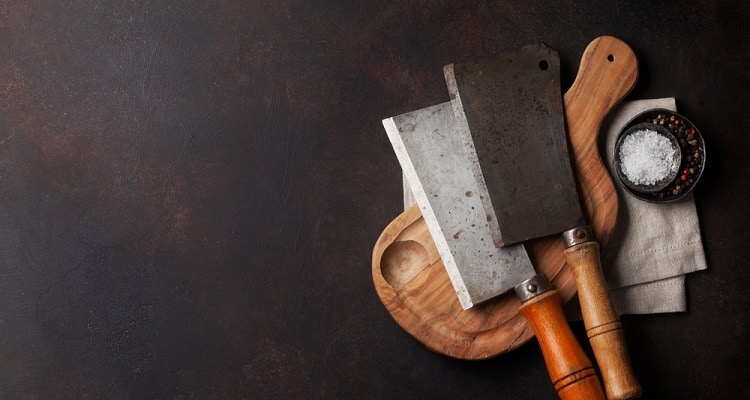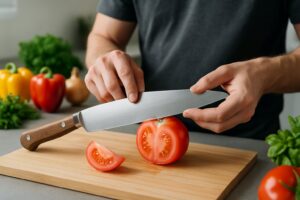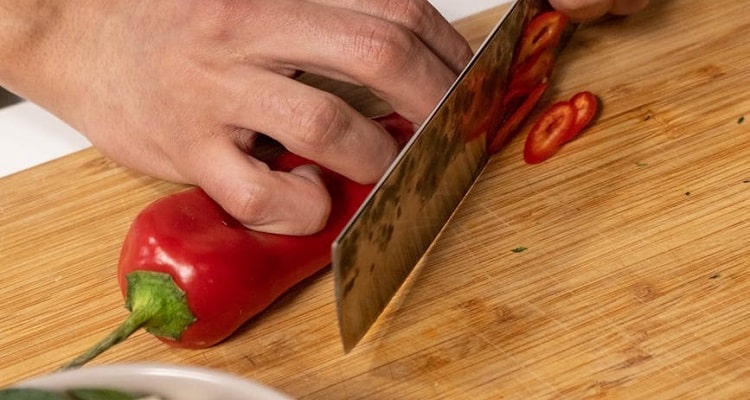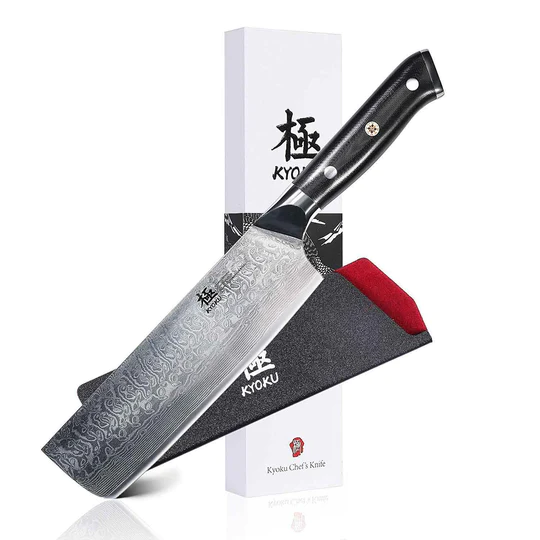


Choosing the right kitchen knife can make prepping vegetables faster and easier. You might be wondering if the Nakiri or the vegetable cleaver fits your cooking style. Both knives look similar, but they have important differences.
The Nakiri has a thinner, lighter blade for delicate veggies, while the cleaver is heavier, making it better for tougher tasks like chopping root vegetables. Learn more about both styles in this guide.
Nakiri means “vegetable cutter” in Japanese. A traditional Nakiri features a straight, flat-edge blade measuring around 6 to 7 inches in length. The blade is usually thin and made of carbon steel or stainless steel. Carbon steel gives the Nakiri excellent sharpness and edge retention, though it needs more care to prevent rust. The handle designs are often wood for a natural grip.
Modern Nakiri knives can feature hammered, Damascus, or plain finishes. This blade shape is unique to Japanese cooking and remains popular for its speed and precision when handling produce.
The Nakiri knife works best for vegetables and fruit. The flat edge lets you make full-contact cuts along the board, slicing easily through light produce like cucumbers, carrots, and leafy greens.
Mincing, dicing, and julienning become simpler thanks to the lightness and balance of the knife. Unlike curved chef’s knives or cleavers, the Nakiri’s shape helps you achieve precise, thin slices and uniform cuts.
Because of its thin, sharp blade, it is not good for bones or very hard foods. If you cook a lot of vegetarian dishes or enjoy stir fries and salads, a Nakiri is a useful tool to have in your kitchen.

Pros:
Cons:
The Chinese vegetable cleaver, is a large, rectangular knife commonly used for handling a wide range of kitchen jobs. This tool is known for its distinct shape, versatility, and efficiency when working with vegetables, fruits, and even some meats.
Vegetable cleavers stand out with their broad, rectangular blades, usually ranging from 6 to 8 inches long. The blades are typically made from high carbon steel, providing excellent edge retention and a sharp cutting surface.
Chinese vegetable cleavers differ from Western-style meat cleavers. They have a thinner blade designed for slicing, dicing, and chopping, not breaking down bones. The blade has a flat profile, allowing you to cut all the way down to the cutting board in one motion.
Most handles are made from wood or synthetic materials, offering a comfortable, secure grip. Some cleavers have full-tang construction for better balance and durability. The design makes it easy to use for both beginners and professionals.
A vegetable cleaver proves most useful when you need to chop, slice, or dice vegetables quickly. This knife can handle tasks such as shredding cabbage, slicing carrots, or mincing garlic. The large flat blade is also handy for scooping up chopped ingredients and moving them to the pan.
Besides vegetables, you can slice boneless meats and soft fruits. Some cooks even use the flat side to crush garlic or ginger. However, it is not designed for cutting through bones or heavy-duty butchering.
Chinese chefs prefer this cleaver for its versatility and speed. With practice, you can use the rocking motion of the blade to make fast and precise cuts in all kinds of produce.
When choosing between a Nakiri and a vegetable cleaver, consider how each knife is designed, how it feels in your hand, and how it performs different tasks. Blade shape, weight, cutting technique, and edge hardness all affect your results and comfort in the kitchen.
The Nakiri knife has a slim, rectangular blade that usually measures between 5 to 7 inches long. Its blade is thin from spine to edge and has a blunted tip with a slight curve, making it easier to cut clean, even slices of vegetables.
The Chinese vegetable cleaver also has a rectangular blade, but it is taller and a bit thicker than the Nakiri. Blade lengths commonly range from 6 to 8 inches. The blade ends in a straight line, creating a blunt, squared-off tip.
The extra blade height in a Chinese cleaver lets you scoop up chopped ingredients and cut through larger produce, like cabbage or squash. The Nakiri’s flatness and slim shape make it simple to line up thin, even slices. Both designs avoid pointed tips, but the cleaver’s extra surface area gives it more heft.
A Nakiri knife is lightweight and well-balanced, making it easy to control for quick, detailed work. Its manageable size and low profile let you chop with less fatigue, even if you prep lots of vegetables.
In contrast, a vegetable cleaver is heavier and has a more substantial blade. This weight helps when tackling firm or dense produce. The tall blade also shifts the balance higher off the cutting board, which some cooks enjoy for its leverage, though it can feel bulky if you are new to cleavers.
You may find the Nakiri easier to use for long prep sessions, but the cleaver’s heft helps you cut through tougher or larger items with less effort. Each offers a different feel and balance that impacts your control and speed.
A cleaver can be used for both chopping and slicing. You still use mostly up-and-down cuts, but the added weight lets you push through larger or denser items with more force. The height makes it easier to scoop food off the board.
The cleaver also works for smashing garlic and crushing ginger, which the Nakiri’s thinner blade cannot handle as well. While both knives allow for fast prep work, your hand motion with the cleaver may need some adjustment if you are used to western-style rocking.
With a Nakiri, you use an up-and-down chopping motion, moving the blade vertically through foods. The flat blade makes full contact with the board, resulting in even, consistent slices. This technique works well for prepping fine, delicate vegetables or quickly producing thin strips.
Choosing between a Nakiri and a vegetable cleaver depends on who will use the knife, what you want to cut, and your budget. Each knife works best in different situations, so consider comfort, performance, and value to make the right choice.
Home cooks and professional chefs often have different needs. At home, you might want a knife that is easy to use, quick to clean, and comfortable to hold for everyday meals. The Nakiri’s lightweight feel and straight blade make it excellent for slicing, dicing, and chopping vegetables quickly. It works well for people who prep lots of fruits and veggies and want straight, even cuts.
Chefs in a restaurant or commercial kitchen may prefer a vegetable cleaver. The broader blade cuts through larger veggies, breaks down small bones, and scrapes ingredients off the board. It handles a higher workload and works for many kitchen tasks. Many chefs choose durable options such as carbon steel or other sturdy metals, which help them work faster and keep a sharp edge longer.
| Role | Best Option | Best for |
|---|---|---|
| Home Cook | Nakiri | Precise vegetable prep |
| Professional Chef | Vegetable Cleaver | Heavy duty, multitasking |
Proper care keeps your Nakiri knife and vegetable cleaver sharp, safe, and long-lasting. Good habits with cleaning, sharpening, and storing help you get the best performance from each knife for years.
Sharpen your Nakiri and cleaver regularly with a whetstone or sharpening rod. For carbon steel blades, hone every few uses to keep the edge straight and sharp.
Wipe your knives clean by hand after each use and dry them right away. Do not soak knives in water or wash knives in the dishwasher, as this can dull or damage the edge.
If you use a carbon steel knife, it will develop a patina over time that protects it from rust. Lightly oil the blade with food grade mineral oil to prevent corrosion, especially in humid climates.
Check the knife edge for chips or dings before sharpening. A sharpening angle of about 15-17 degrees works for a Nakiri, while a vegetable cleaver is usually best around 18-20 degrees. Use light, even strokes for best results.
Store your Nakiri and cleaver in a way that protects the blade. The best options are a knife block, magnetic strip, or a blade guard. This keeps the edge from getting nicked and reduces the risk of accidents.
If you keep your knives in a drawer, use blade covers or a soft towel to separate them from other utensils. This is especially important for thin blades like the Nakiri.
Humidity can speed up rust, so keep your knives dry and avoid storing them in damp areas. Hang a vegetable cleaver or place it in a rack where air can circulate.
Routine care and proper storage, especially for carbon steel knives, help maintain sharpness and prevent rust.
Understanding the differences between a Nakiri and a Chinese Vegetable Cleaver can help you choose the right tool for your meal prep. Durability, ease of use, and versatility depend on the design of each knife.
A Nakiri knife has a thin, flat-edged blade designed mainly for slicing and chopping vegetables. Its blade is usually lighter and narrower compared to a Chinese Vegetable Cleaver.
A Chinese Vegetable Cleaver features a larger, broader blade with more weight. It can handle vegetables, fruit, and even some meat. The cleaver’s double-beveled edge and heavier design add to its versatility.
If you often prepare a wide range of vegetables and sometimes want to cut small pieces of meat, a Chinese Vegetable Cleaver is a strong choice. Its size allows for chopping, slicing, and even tenderizing.
A Nakiri offers more precision for thin slicing, especially with softer produce. However, it lacks the strength to handle harder items or light bones.

A Chinese Cleaver is heavier and broader, which lets you cut a variety of foods quickly. You can chop, mince, and use the flat side for smashing garlic or transferring chopped food to a pan.
The wider blade also makes it easier to scoop up ingredients. If you want to do more than just slice vegetables, cleavers are more flexible in the kitchen.
Both knives often use high-carbon steel, which helps their edges stay sharp. A Nakiri from top brands usually has strong edge retention due to its thinner blade and quality materials.
High-quality Chinese cleavers, such as Shun or Shibazi (Shi Ba Zi Zuo), are also made for excellent edge retention across a range of cutting tasks. Both options stay sharp if you maintain and sharpen them properly.
A Nakiri specializes in straight, downward cuts because of its flat blade. This makes it best for even slices and clean cuts across the entire blade length.
A Santoku, while good for vegetables, usually has a shorter, slightly curved blade. It handles more varied tasks well but may not match the Nakiri’s precision.
A Shibazi Cleaver can handle a similar range of vegetable prep because of its thin, broad blade. You can use it for quick chopping, slicing, and dicing.
It is heavier than a Nakiri, but many chefs find it more versatile, especially for cutting larger vegetables or small amounts of meat without switching knives.

Knife Buzz offers independent product reviews on a wide range of knives used in the kitchen, home, and outdoors. We make it easy for you to find the right knife at the best price.